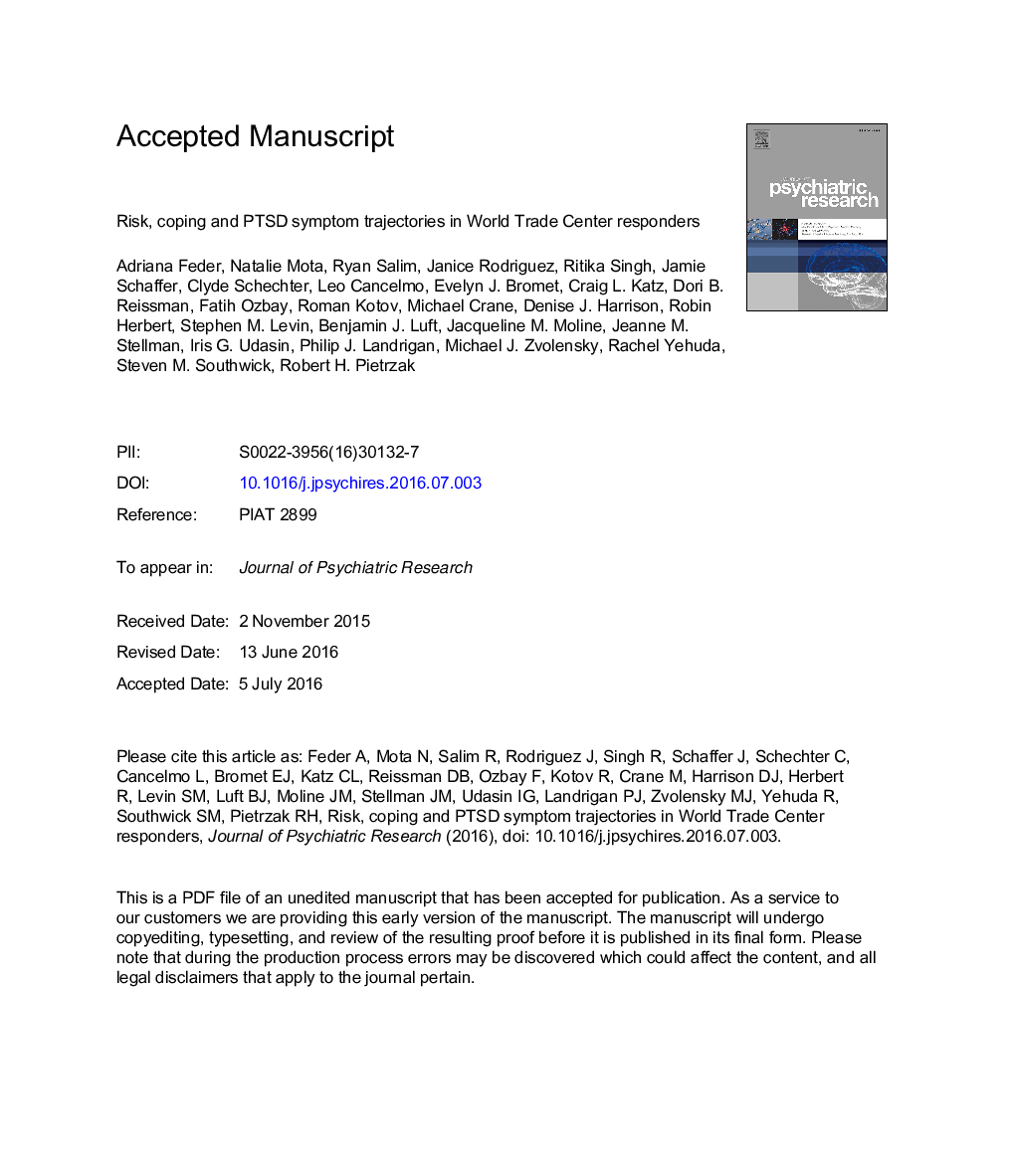| کد مقاله | کد نشریه | سال انتشار | مقاله انگلیسی | نسخه تمام متن |
|---|---|---|---|---|
| 6799924 | 542920 | 2016 | 42 صفحه PDF | دانلود رایگان |
عنوان انگلیسی مقاله ISI
Risk, coping and PTSD symptom trajectories in World Trade Center responders
دانلود مقاله + سفارش ترجمه
دانلود مقاله ISI انگلیسی
رایگان برای ایرانیان
کلمات کلیدی
موضوعات مرتبط
علوم زیستی و بیوفناوری
علم عصب شناسی
روانپزشکی بیولوژیکی
پیش نمایش صفحه اول مقاله

چکیده انگلیسی
Trajectories of disaster-related posttraumatic stress disorder (PTSD) symptoms are often heterogeneous, and associated with common and unique risk factors, yet little is known about potentially modifiable psychosocial characteristics associated with low-symptom and recovering trajectories in disaster responders. A total of 4487 rescue and recovery workers (1874 police and 2613 non-traditional responders) involved during and in the aftermath of the unprecedented World Trade Center (WTC) attacks, were assessed an average of 3, 6, 8, and 12 years post-9/11/2001. Among police responders, WTC-related PTSD symptoms were characterized by four trajectories, including no/low-symptom (76.1%), worsening (12.1%), improving (7.5%), and chronic (4.4%) trajectories. In non-traditional responders, a five-trajectory solution was optimal, with fewer responders in a no/low-symptom trajectory (55.5%), and the remainder in subtly worsening (19.3%), chronic (10.8%), improving (8.5%), and steeply worsening (5.9%) trajectories. Consistent factors associated with symptomatic PTSD trajectories across responder groups included Hispanic ethnicity, pre-9/11 psychiatric history, greater WTC exposure, greater medical illness burden, life stressors and post-9/11 traumas, and maladaptive coping (e.g., substance use, avoidance coping). Higher perceived preparedness, greater sense of purpose in life, and positive emotion-focused coping (e.g., positive reframing, acceptance) were negatively associated with symptomatic trajectories. Findings in this unique cohort indicate considerable heterogeneity in WTC-related PTSD symptom trajectories over 12 years post-9/11/2001, with lower rates of elevated PTSD symptoms in police than in non-traditional responders. They further provide a comprehensive risk prediction model of PTSD symptom trajectories, which can inform prevention, monitoring, and treatment efforts in WTC and other disaster responders.
ناشر
Database: Elsevier - ScienceDirect (ساینس دایرکت)
Journal: Journal of Psychiatric Research - Volume 82, November 2016, Pages 68-79
Journal: Journal of Psychiatric Research - Volume 82, November 2016, Pages 68-79
نویسندگان
Adriana Feder, Natalie Mota, Ryan Salim, Janice Rodriguez, Ritika Singh, Jamie Schaffer, Clyde B. Schechter, Leo M. Cancelmo, Evelyn J. Bromet, Craig L. Katz, Dori B. Reissman, Fatih Ozbay, Roman Kotov, Michael Crane, Denise J. Harrison, Robin Herbert,